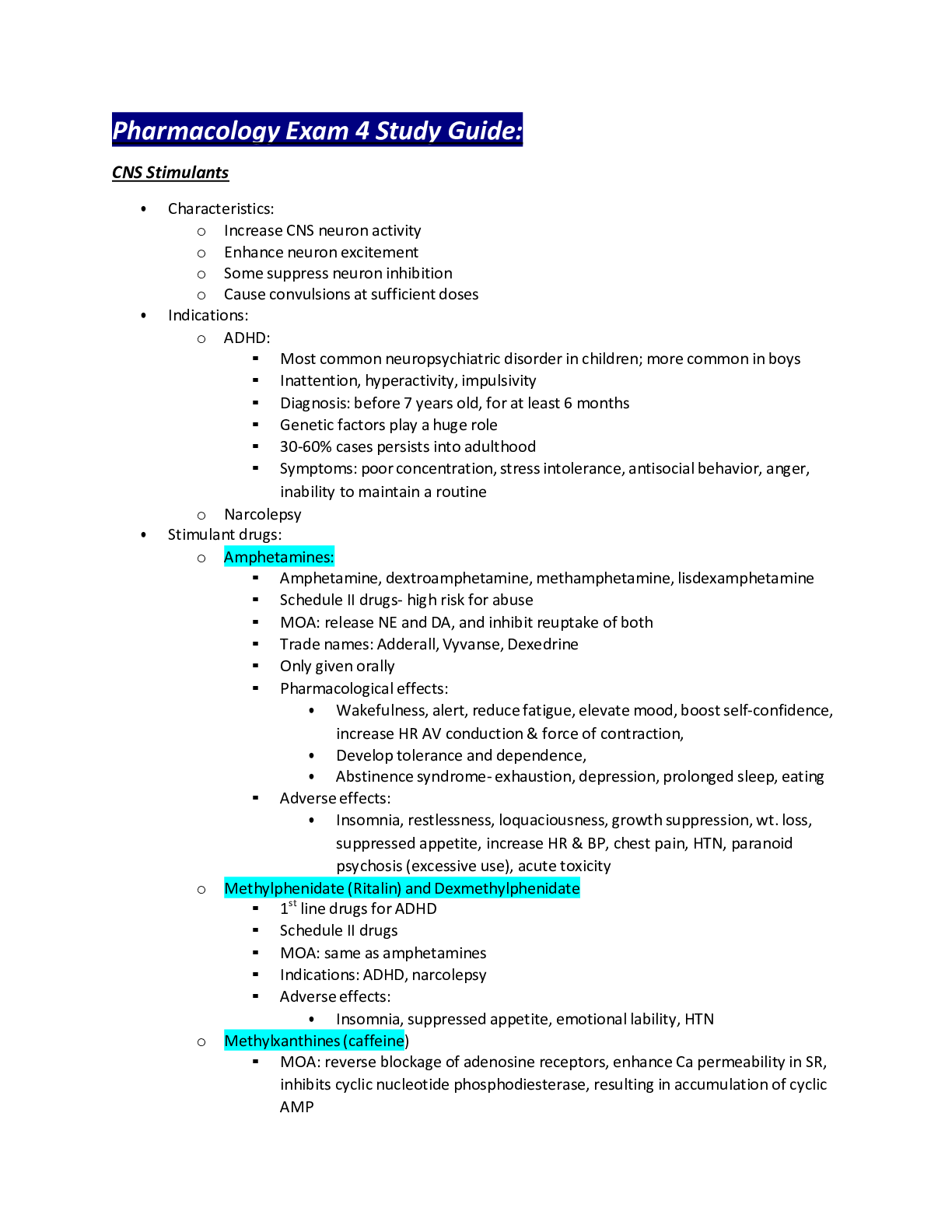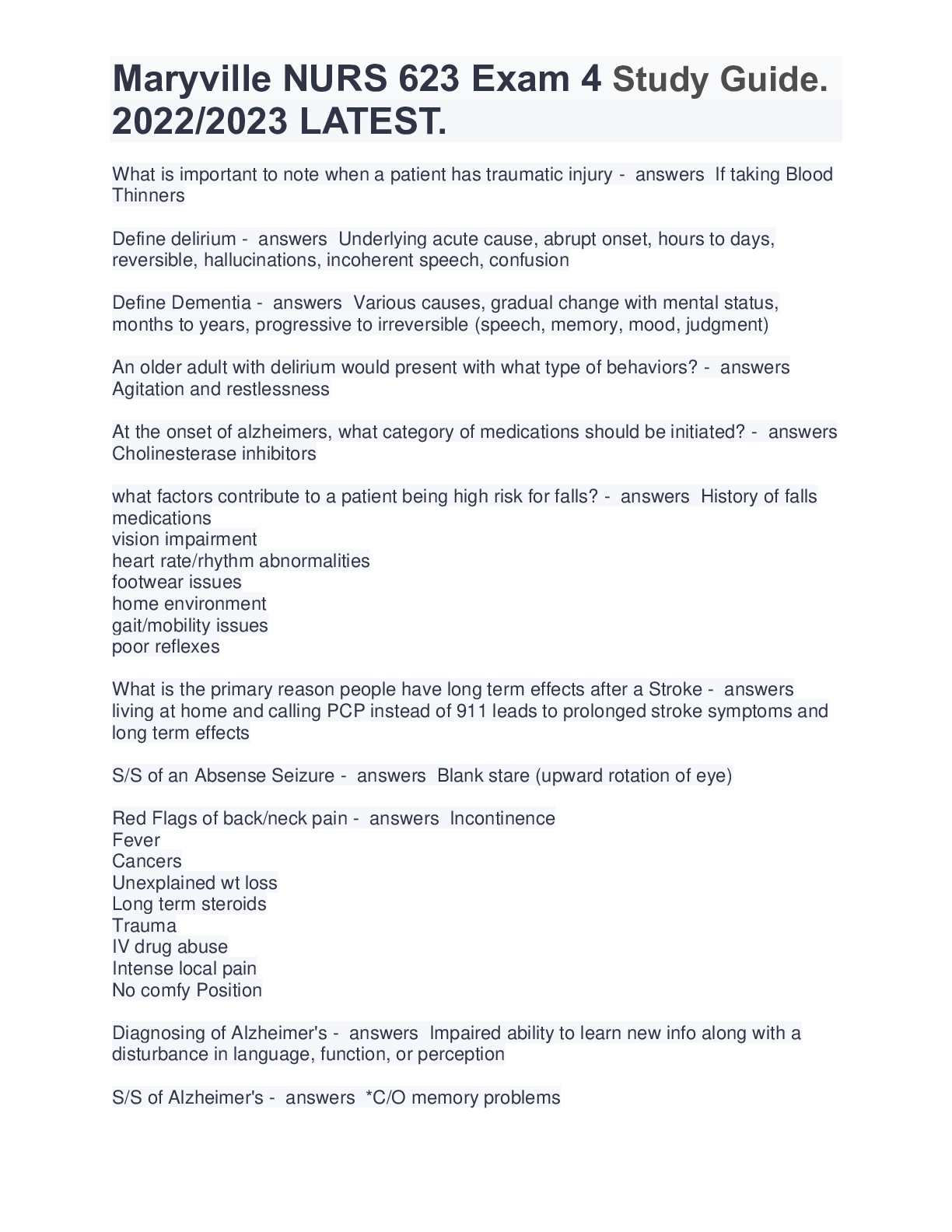C787 Module 4 Study Guide.
Document Content and Description Below
Unit 4: Nutrition and Physical Activity (Cohort 2 Video) Reading: "Physical Activity and Health" at Centers for Disease Control and Prevention Identify exercise recommendations for populations - chi... ldren, adults, adults with weight loss goals. What recommendations would you give a patient who would like to increase their physical activity level? Preschool (3-5): physically active throughout day Children/adolescents (6-17): 60 mins + of moderately vigorous physical activity/day Adults: some is better than none. Any amount of mod vigorous activity has health benefits Older Adults: weekly phy activity- multicomponent activity that includes balance training w/ aerobic & muscle-strengthening activity. During/After Pregnancy: @ least 150 mins of mod intensity aerobic activity/week Adults w/ chronic conditions/disabilities (if able): @ least 150-300 mins/week of mod intensity of 75-150 mins/week of vigorous activity Adults w/ weight loss goals: many need >150 mins of mod intensity activity/week to maintain wt. If want to lose >5% of body wt/keep wt off, need >300 mins of mod intensity activity/week What recommendations would you give a patient who would like to increase their physical activity level? Risk of injury is r/t gap between usual & new activity levels. o Size of this gap is called Amount of Overload. Creating a small overload & waiting for body to adapt/recover decreases injury risk. Physical activity should be increased gradually over time (no matter the current activity level) Key Points: 1. Use relative intensity (intensity of activity relative to fitness) to guide level of effort for aerobic/muscle strengthening 2. Start w/ relatively mod-intensity. Avoid vigorous. 3. First, increase # of mins/session & # days/week of mod intensity. Later increase intensity. 4. Pay attention to relative size of increase activity/week, as this is r/t increased injury risk. What are health benefits of exercise for those with chronic diseases? * Overall, decreased anxiety/depression/improved sleep & quality of life. * For those w/ osteoarthritis: lowers risk of other chronic disease (heart disease/type 2 diabetes) * For those w/ type 2 diabetes: can decrease chance of developing comorbidities & prevent risk factors that cause progression of the diabetes * For those w/ HTN: decreases b/p & risk of cardiovascular mortality * For those w/ breast/colorectal/prostate cancers: increased activity after diagnosis substantially lowers risk of dying from their CA * For those w/ many types of disabilities: activity decreases pain, improves physical fitness, increases physical function/quality of life What diseases/conditions are linked to lack of exercise? Type 2 diabetes, HTN, heart disease, osteoporosis, variety of cancers How do you calculate a PAL (physical activity level)? * Physical activity level (PAL) takes into account daily energy expenditure (TDEE) & basal metabolic rate (BMR) * Equation written as: PAL = TDEE/BMR Reading: "Diabetes, Eating and Physical Activity" at National Institute of Diabetes and Digestive and Kidney Diseases Identify foods recommended for a diabetic patient This study source was downloaded by 100000831777157 from CourseHero.com on 08-01-2022 03:28:07 GMT -05:00 https://www.coursehero.com/file/58253282/C787-Module-4-Study-Guidedocx/ Variety of healthy food from all food groups Veggie: starchy (potatoes, etc.) & non-starchy (carrots, etc.) Fruits: oranges etc. Grains: ½ of which should come from whole grains Proteins: lean meats, fish, eggs No fat or low-fat dairy Foods w/ heart-healthy fats (oils such as canola/olive oil; nuts/seeds/heart healthy fish; avocado) Identify foods that should be avoided by the diabetic patient. Do not use butter, but use oils when cooking Limit fried food or food high in saturated/trans fat Limit sodium, sweets & beverages w/ added sugars What are two common meal plan methods that can help diabetic patients manage their diet and how do they provide guidelines for meal planning? 1. Plate Method: helps control portion size. No calorie counting. Shows amount of each food group you should eat. Best for lunch/dinner. 2. Carb Counting: tracks carbs you eat/drink. Useful because carbs convert to glucose in the body and glucose affects blood sugar levels. This method can help manage BS level. Right amount needed varies by how you manage your diabetes, including how active you are & what meds you take. Carbs measured in grams & total for day is added. Try to limit carbs w/ added sugars or refined sugars. What is medical nutrition therapy (MNT)? A service provided by a RD to create eating plans based on your likes/needs. Has been shown to improve diabetes management. What are recommendations for managing blood sugar with exercise? hypoglycemia also can occur after a long intense workout or if you have skipped a meal before being active. Hypoglycemia can happen during or up to 24 hours after physical activity. You may need to check your blood glucose level before, during, and right after you are physically active. What are recommendations for diabetics to control hypoglycemia? Planning is key to preventing hypoglycemia. You may need to take less insulin or eat a small snack with carbohydrates before, during, or after physical activity, especially intense activity. Differentiate between the following types of activity: Aerobic: activity that makes your heart beat faster and makes you breathe harder Muscle-strengthening: make muscles do more work than they are accustomed to doing. Resistance training, including weight training is an example. Bone-strengthening: produce an impact or tension force on the bones that promotes bone growth/strength. Ex [Show More]
Last updated: 2 years ago
Preview 1 out of 3 pages

Buy this document to get the full access instantly
Instant Download Access after purchase
Buy NowInstant download
We Accept:

Reviews( 0 )
$11.50
Can't find what you want? Try our AI powered Search
Document information
Connected school, study & course
About the document
Uploaded On
Aug 01, 2022
Number of pages
3
Written in
Additional information
This document has been written for:
Uploaded
Aug 01, 2022
Downloads
0
Views
67

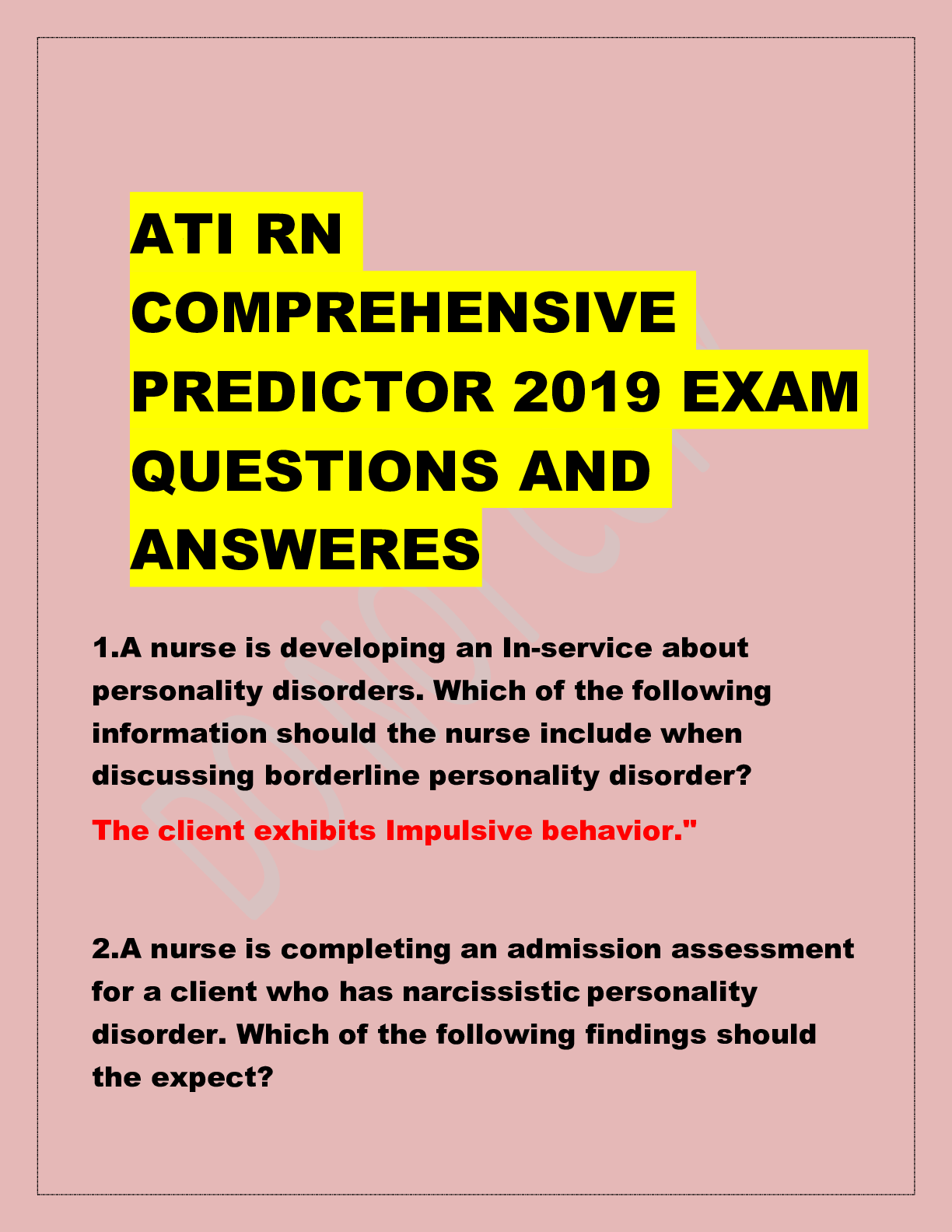


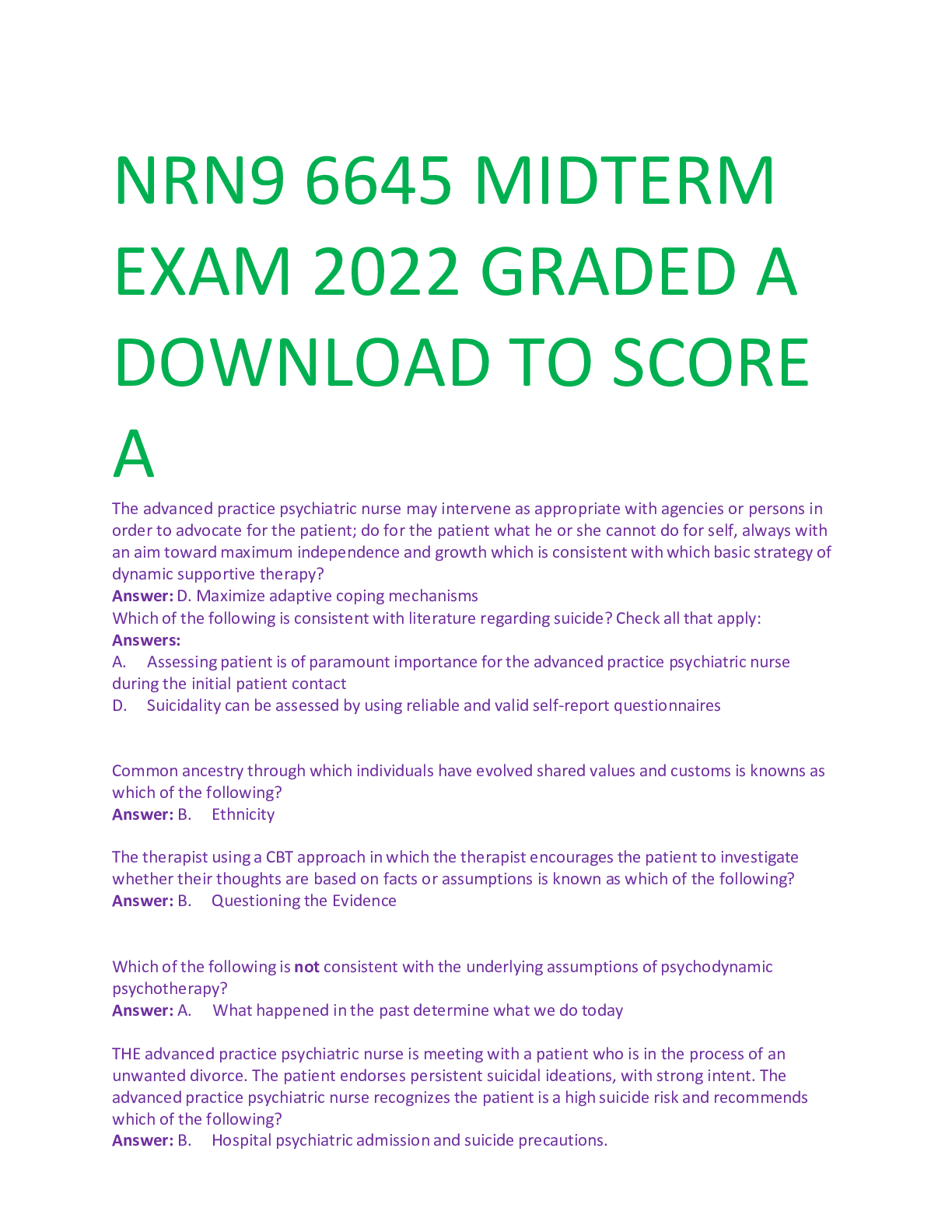

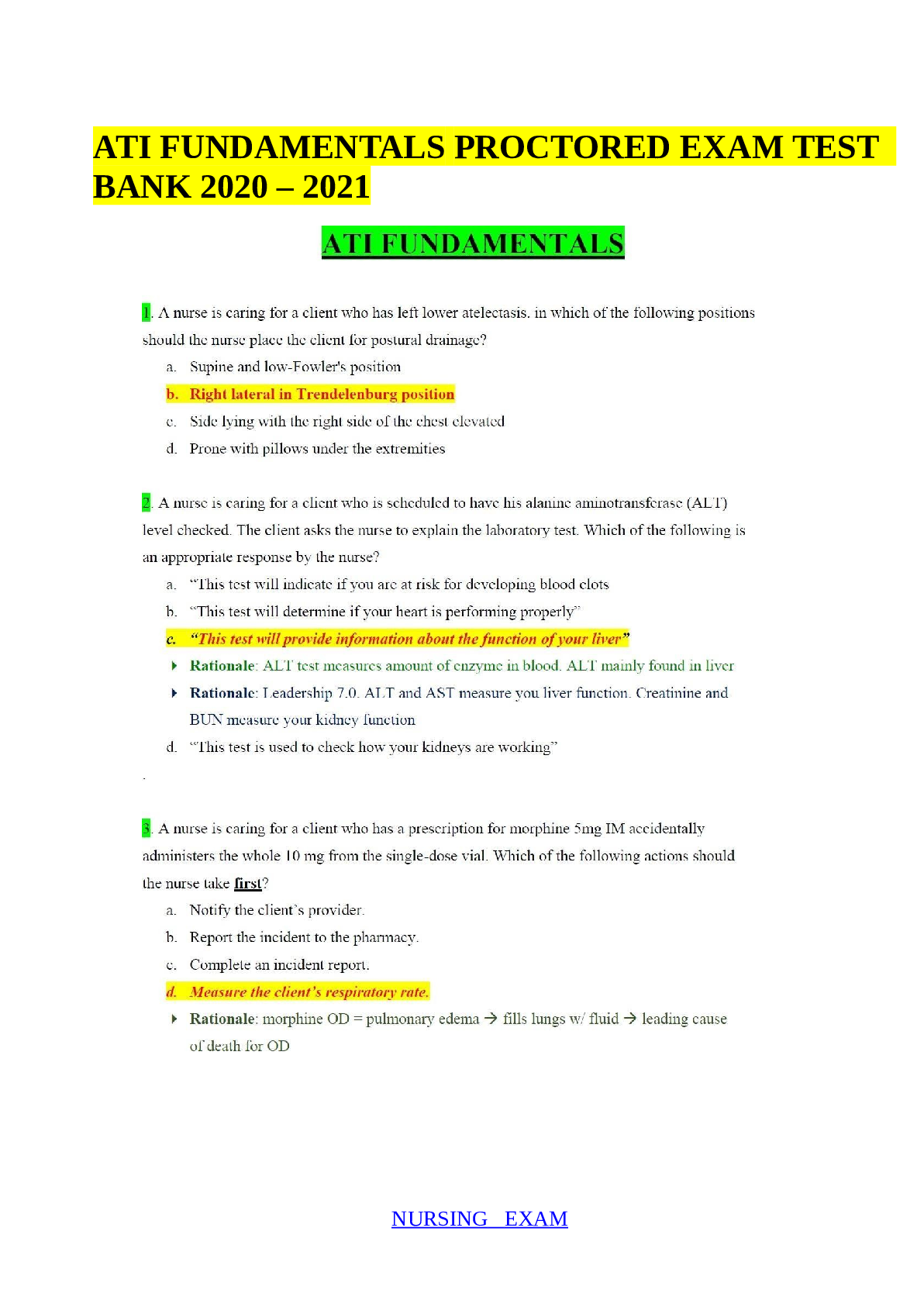
.png)
.png)



